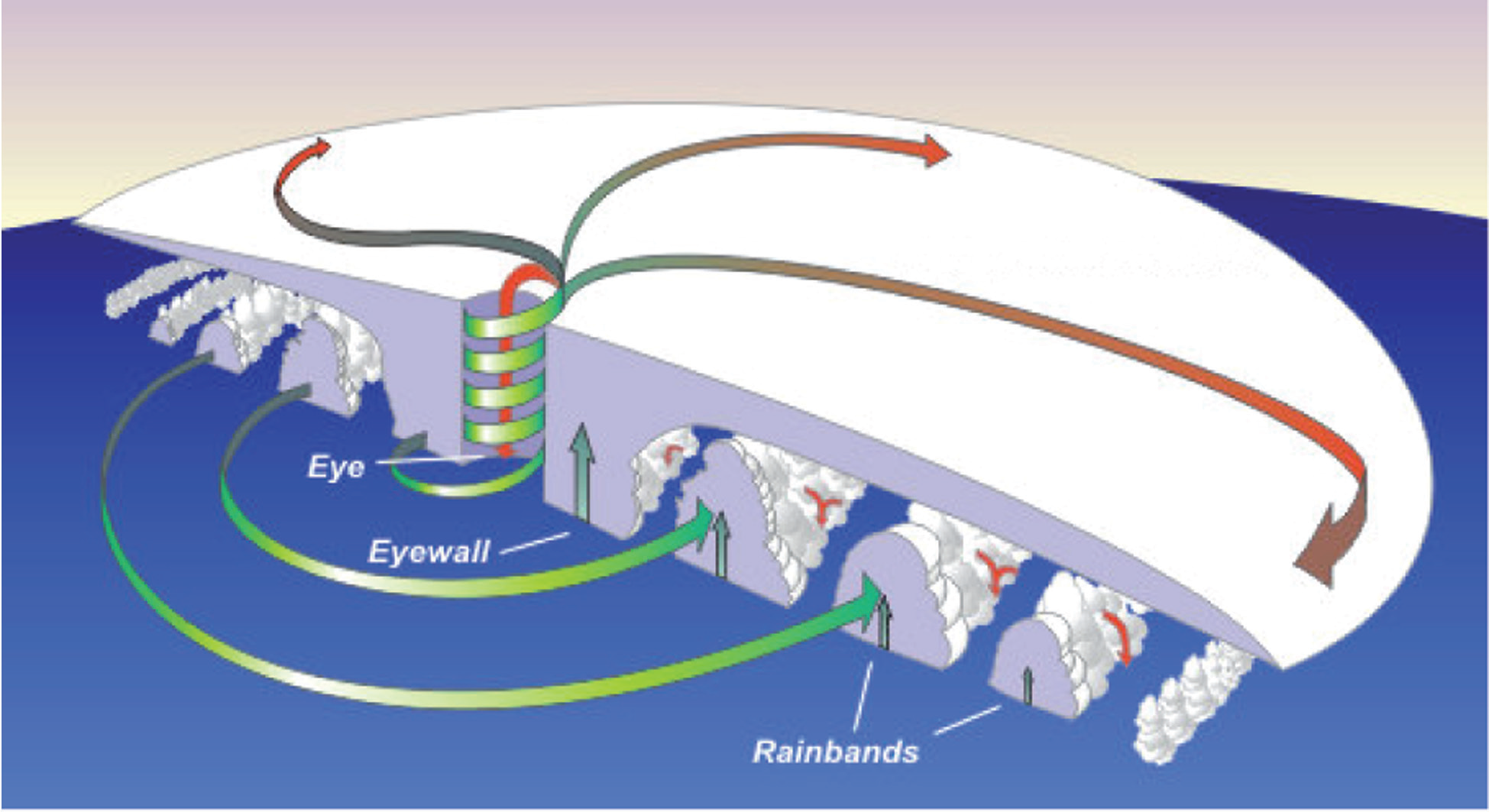| Date | November 2012 | Marks available | 6 | Reference code | 12N.2.bp.7 |
| Level | SL and HL | Paper | 2 | Time zone | |
| Command term | Explain | Question number | 7 | Adapted from | N/A |
Question
The diagram shows the structure of a typical hurricane (typhoon, tropical cyclone) in the northern hemisphere.

[Source: http://library.thinkquest.org/03oct/00758/en/disaster/hurricane/structure.jpg]
Describe the atmospheric conditions in the eye and the eyewall of a typical hurricane.
Explain the conditions needed for the occurrence of a hurricane hazard event.
“Rich countries experience hazard events while poor countries experience disasters.” Discuss this statement with reference to one named hazard type.
Markscheme
In the eye the air is shown to be descending/warming [1 mark]. This results in calm weather and clear skies [1 mark].
In the eyewall the air is rising, rotating around the eye / cooling [1 mark]. This results in strong winds and heavy rain [1 mark].
Accept other plausible answers such as references to the release of latent heat in the eyewall causing rapid uplift / atmospheric pressure variations.
Valid conditions might include:
- warm ocean temperatures of 26/27° C provide the energy for the hurricane due to high rates of evaporation that trap latent heat which is released when condensation occurs during uplift
- suitable distance from the equator – allows the Coriolis force to operate giving rotation to the storm
- a stable atmosphere with no wind shear – the lack of variable wind speed with altitude allows vertical development of the storm to occur
- allow other valid conditions such as warm water depth of 50 m
- concentrated/vulnerable population in areas where the hazard is likely to strike e.g. coastal areas / removal of mangrove etc.
Answers should consider at least two conditions in detail or more in less detail to gain full marks. There should be some acknowledgement of the human dimension of the hazard event for maximum marks.
Answers should distinguish between a hazard (a threat that may cause loss of life or damage to property and the environment) and a disaster (resulting from a major hazard event and causing significant disruption, losses to life, property and ecosystems that the affected community is unable to deal with adequately without outside help).
Answers depend upon the type of hazard chosen but should refer to only one hazard type. It is expected that answers will discuss the ways in which rich countries are able to introduce measures that mitigate the effects of a hazard event thus reducing its impacts while poor countries are less able to do this and remain more vulnerable to the impacts of hazard events. It is expected that examples of hazard events from rich countries and poor countries would be included to illustrate this. Good answers may suggest that rich countries are also vulnerable to disasters dependent on the intensity and location of the hazard event.
Answers that refer to multiple hazards should only be credited for the best of these. Answers that simply describe hazard events in poor countries and rich countries should not move above band D. To reach bands E and F a balanced discussion is expected.
Marks should be allocated according to the markbands.
Examiners report
Atmospheric conditions were not well understood but relative conditions between eye and eyewall were fine. Too many answers referred only to the weather experienced in the eye and eyewall rather than the atmospheric conditions, for example, few mentioned descending air in the eye and the rapid upward spiralling of air in the eyewall.
There was a good understanding of natural conditions necessary for formation of a hurricane but many missed the “hazard event” part of the question, and did not include any reference to human factors.
Weaker candidates focused on the case study and not the evaluation of the strategies. A significant error was the inability to distinguish between a hazard and a disaster, with weaker candidates merely comparing an event in an LEDC with an MEDC. Some referred to more than one hazard type. Stronger responses showed good differentiation between the impacts on rich/poor nations though many persist with the idea that evacuation before an earthquake is possible in rich countries. The use of some well-chosen examples were deconstructed with sound evaluation.

